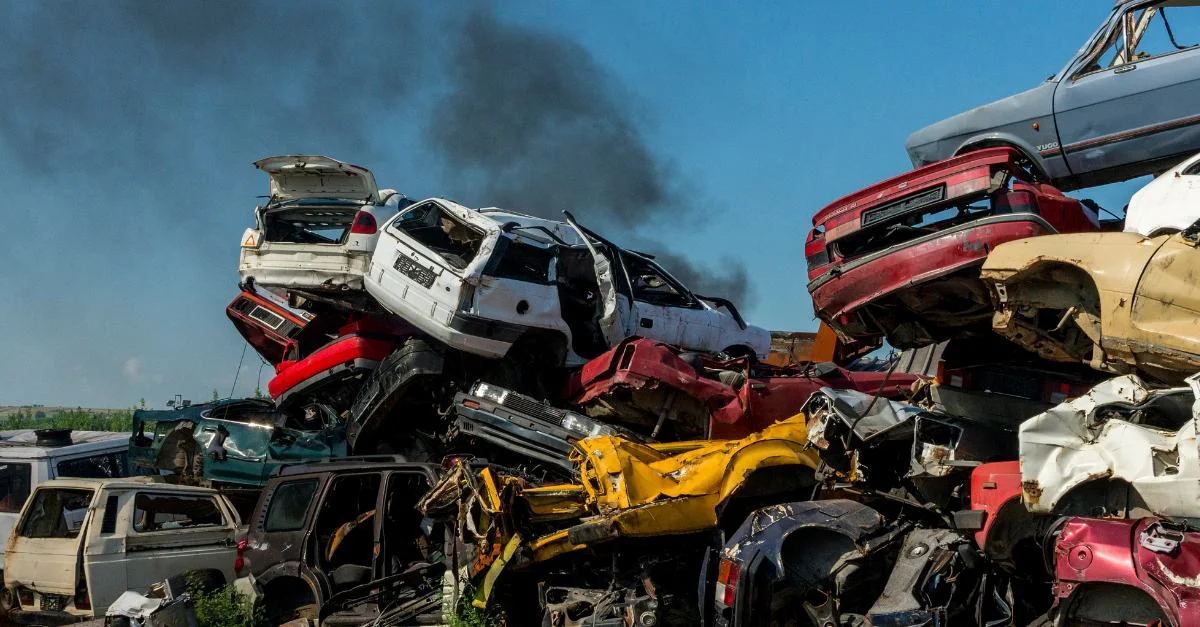Car recycling is the process of depollution, dismantling and destruction of a car. The process is undertaken at an Authorised Treatment Facility (ATF) where as much of the car as possible is recovered. The process is governed by the EU waste directive which aims at the reduction of waste arising from end-of-live vehicles.
On this page:
When a car reaches the end of its working life, it can still keep a high value and scrap car recycling can be a pleasingly lucrative process. Whilst your car may no longer be fit for the road after a certain amount of time, it is still of use to scrap dealers due the metal weight and spare parts that it houses. The metal that you’ll find in a scrapped car alone is of high value for many working in the scrap trade. Once a car is shredded, the metal is recycled, allowing us to once again make use of one of the world’s most sought-after materials. 65% of a car is made from steel, with the remaining 35% being made up by other metals plus glass and other materials. Recycling metal is far more energy-efficient than producing new metal, and around a quarter of the world’s steel today is made up of recycled steel.

The vehicle recycling process
Vehicle recycling takes place at an ATF. Reputable car scrappers like National Scrap Car will always use an ATF as these facilities operate under strict regulatory guidelines and ensure no corners are cut during the process. The recycling process has three main steps.
- Depollution
Depollution is the process where all the hazardous materials and parts are safely removed. This step is incredibly important as it is takes care of anything that is hazardous to the environment.
- Dismantlement
Dismantlement is where the vehicle is broken down into parts that are reusable. This could mean simply removing parts that are in good condition for re-use in other vehicle, or parts disassembled for their components. A good example of this would be the dismantlement of a catalytic convertor, a part of the vehicle that contains valuable, precious metals.
- Destruction
The third stage of the process involves preparing the remaining metal shell for crushing and sending to the metal mill for melting down. There are three steps in the destruction process:
- Magnetic separation – separating the steel from the other recyclable parts of the vehicle
- Detinning – the car removal of the thin layer of tin that covers the shell of a modern vehicle and prevents rusting.
- Melting – The remaining steel body is melted down in a furnace and then rolled into sheets ready for re-use. Recycling steel uses less energy than producing new steel from ore, so is a very environmentally friendly way of creating steel ready for use in a wide range of processes, not just car for manufacture.
What parts of a car can be recycled?
It can be surprising to find out just how much of a car can be recycled. Here are some of the main car parts and their uses:
- Metal body – melted ready for re-use for any manufacturing or construction process that requires steel
- Interior fabric – shredded and re-used in home furnishings
- Interior leather – recycled for use as handbags, belts of other clothing and accessories
- Dashboard plastics – recycled and re-used as plastic bags, carpets, plastic furniture, or other plastic products
- Tyres – recycled into pellets and used on artificial sports pitches or to surface children’s playgrounds
- Batteries – the metal within car batteries, particularly cobalt, can be recycled
- Catalytic convertor – numerous precious metals are used in the production of catalytic convertors (which is why they can be the target of theft from regular vehicles), it is desirable to recycle these
- Glass – the glass from car windows is removed, the laminate covering is separated from the glass, and the glass is then recycled and can be used on other glass products
- Engine oil – can be re-used for fuel by container ships
How much could you get for recycling your car?
The amount you could get for recycling cars depends on numerous factors. You can find out more about scrap car prices here. There are numerous factors that come into play when estimating scrap car value, including make, model and condition. The best way to find out how much you could get to recycle your car is to use our quote form at the top of this page.
Car recycling near me
Although you have to have your car recycled by an ATF, you won’t have to find an ATF and deliver it there yourself. We have a network stretching throughout the UK and we provide scrap car collection services and will pick up your car from your house, garage or other convenient location. It is incredibly easy to get paid for your vehicle and have it collected quickly. Contact us today to find out more.
Recycling FAQs
Where can I recycle car batteries?
Car batteries can be recycled at some garages, scrap metal yards / ATF’s and many household waste recycling centres. If you were recycling your whole car the battery would not need to be recycled separately.
How much of a car can be recycled?
65% of a car is made up of steel, all of which is recyclable. Much of the remaining 35% is also recyclable. The current target is for 95% of a vehicle to be recycled.
Can any car be recycled?
All end-of-life vehicles should be recycled. Any car that would be too costly to keep on the road could also be recycled.
How much does vehicle recycling cost?
All vehicles have value, recycling a car should not cost you any money. On the contrary, we’ll pay you to do it!